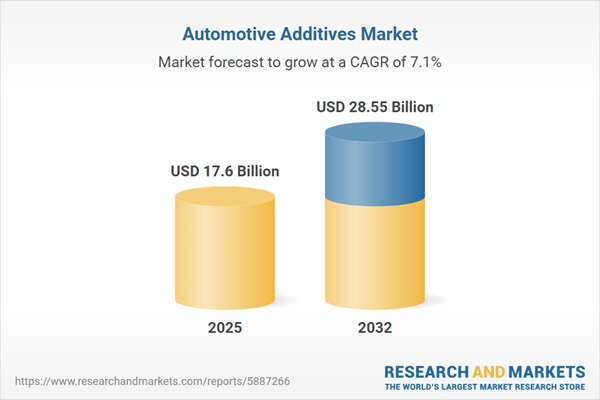Speak directly to the analyst to clarify any post sales queries you may have.
Senior leaders in the automotive additives sector are confronted with growing complexity, rapid regulatory change, and a fast-evolving supplier landscape. Navigating these pressures requires organizations to leverage real-time market intelligence and organizational flexibility, ensuring sustained competitiveness and operational resilience in a shifting environment.
Market Snapshot: Automotive Additives Market Size and Growth
The global automotive additives market stands at USD 16.45 billion in 2024 and is projected to reach USD 17.60 billion in 2025. By 2032, the market is forecast to expand to USD 28.55 billion, propelled by a robust 7.13% compound annual growth rate (CAGR). Regulatory pressures, rising digitalization in automotive manufacturing, and ongoing innovations in additive chemistry drive sector expansion. Growing adoption of electric vehicles is fueling demand for advanced, application-specific solutions. Asia-Pacific continues to strengthen its manufacturing and R&D leadership, while North America and Europe focus on resilient supply chains and sustainable practices. To succeed in this dynamic landscape, it is essential for organizations to integrate up-to-date information with agile business strategies.
Scope & Segmentation: Analysing Dimensions of the Automotive Additives Market
- Product Types: Brake fluid additives, coolant additives, engine oil additives, fuel additives, grease additives, and transmission fluid additives—integral to improving performance and durability across automotive applications.
- Functional Applications: Anti-wear agents, corrosion inhibitors, detergent dispersants, friction modifiers, pour point depressants, and viscosity improvers, each contributing to operational efficiency, compliance, and longer maintenance intervals.
- Vehicle Classes: Passenger vehicles, commercial fleets, and off-road equipment each depend on targeted additive solutions to address performance and environmental demands.
- Raw Materials: Mineral, semi-synthetic, and synthetic base stocks, enabling adaptability to evolving regulations and supporting organizational sustainability goals.
- Sales Channels: Dealerships, online distributors, independent service providers, and logistics firms provide market access tailored to regional and industry requirements.
- Formulations: Ready-mix, concentrated liquids, powders, and solids support flexible product customization to align with OEM and supplier quality standards.
- Regions: Americas, Europe, Middle East, Africa, and Asia-Pacific, each influenced by distinct regulatory, technological, and adoption drivers that shape strategic approaches.
- Leading Companies Analyzed: BASF SE, The Lubrizol Corporation, Infineum International Limited, Chevron Oronite, Afton Chemical, Clariant AG, Evonik Industries, Croda International, Arkema S.A., and Innospec Inc.—each maintaining a competitive edge through collaborative innovation and cross-functional expertise.
Key Takeaways: Strategic Insights for Senior Decision-Makers
- Advances in biodegradable and low-toxicity additives are shifting industry priorities, with organizations adjusting innovation pipelines to address stricter compliance frameworks and future regulatory scenarios.
- The rapid embrace of electric vehicles is prompting faster R&D cycles and the introduction of specialized additive technologies that enhance compatibility and system lifespan.
- Integration of digital tools, such as predictive analytics and digital twin platforms, supports both product development and strategic sourcing in dynamic supply environments.
- Development of decentralized, regionally adaptive supply chains strengthens business agility, enabling a prompt response to global disruptions or changes in trade policy.
- Collaborative supplier relationships are streamlining go-to-market strategies, resulting in more efficient adoption of updated products and consistent regulatory alignment across regions.
Tariff Impact: Navigating Cost Pressures and Supply Chain Adjustments
Forthcoming tariff changes in 2025 are leading market participants to re-evaluate procurement and production models. Investment in regional blending facilities and nearshoring initiatives is accelerating to reduce supply chain vulnerabilities tied to transport and border complexities. Simultaneously, emphasis on closed-loop manufacturing and recyclable additives reinforces corporate sustainability and supports uninterrupted production as international requirements evolve.
Methodology & Data Sources
This analysis combines thorough technical literature reviews, regulatory assessments, and disclosed insights from top industry players. Feedback from R&D and operations specialists, paired with scenario-based market modeling, shapes a comprehensive evaluation of emerging risks and business opportunities.
Why This Report Matters: Value for Automotive Additives Leaders
- Equips senior executives with early indicators of market and regulatory change, enabling swift strategic pivots to capture opportunity and minimize disruption.
- Delivers actionable tools for fortifying supply chain resilience, ensuring business continuity in uncertain or evolving environments.
- Supports well-informed partnership and capital allocation decisions, enhancing both organizational risk management and competitive posture.
Conclusion
In a sector marked by accelerating transformation, automotive additives organizations must prioritize actionable intelligence and flexibility. Applying targeted insights and adaptive strategies positions leadership teams to capitalize on emerging opportunities and maintain operational stability.
Additional Product Information:
- Purchase of this report includes 1 year online access with quarterly updates.
- This report can be updated on request. Please contact our Customer Experience team using the Ask a Question widget on our website.
Table of Contents
3. Executive Summary
4. Market Overview
7. Cumulative Impact of Artificial Intelligence 2025
Companies Mentioned
The companies profiled in this Automotive Additives market report include:- BASF SE
- The Lubrizol Corporation
- Infineum International Limited
- Chevron Oronite Company LLC
- Afton Chemical Corporation
- Clariant AG
- Evonik Industries AG
- Croda International PLC
- Arkema S.A.
- Innospec Inc.
Table Information
| Report Attribute | Details |
|---|---|
| No. of Pages | 188 |
| Published | November 2025 |
| Forecast Period | 2025 - 2032 |
| Estimated Market Value ( USD | $ 17.6 Billion |
| Forecasted Market Value ( USD | $ 28.55 Billion |
| Compound Annual Growth Rate | 7.1% |
| Regions Covered | Global |
| No. of Companies Mentioned | 11 |









